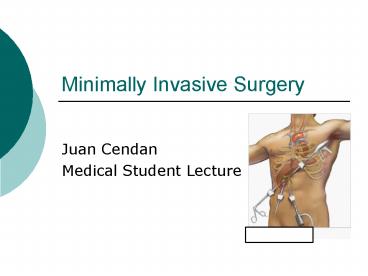Minimally Invasive Surgery - PowerPoint PPT Presentation
1 / 28
Title:
Minimally Invasive Surgery
Description:
... Invasive Surgery. Juan Cendan. Medical Student Lecture ... Can be a problem for patients with COPD. Alternates: helium, air, NO, gasless. Patient position ... – PowerPoint PPT presentation
Number of Views:5405
Avg rating:3.0/5.0
Title: Minimally Invasive Surgery
1
Minimally Invasive Surgery
- Juan Cendan
- Medical Student Lecture
2
Background
- Cystoscopes early 1800s
- Laparoscopy early 20th century
- Laparoscope with video camera 1980s
- 1985 first lap chole (France)
3
Physiology
- Increased intra-abdominal pressure
- Effects (similar to intra-abdominal compartment
syndrome) - Ventilation
- Decreases venous return
- Reduces renal perfusion
- Increases intracranial pressure
- Balance between cardiac function and volume
status
4
Physiology - Exposure
- Gas used is CO2
- Can be a problem for patients with COPD
- Alternates helium, air, NO, gasless
- Patient position
- Pressure points
- Obesity
- Securing patient
5
Benefits
- Decreased pain
- Attenuated stress response
- Early return to ambulation
6
Pulmonary Effects
7
Circulatory Effects
?
8
General Complications of Laparoscopy
- Injury to adjacent organs
- Bleeding solid organs
- Vascular injuries
- Bowel injury (puncture, cautery)
- Bladder/uterus injury
- Access site complications
- Port site hernia
- Wound infection
9
Trocars
10
General Complications, cont
- Specimen removal
- Port site cancer
- Splenosis
- Endometriosis
- Pneumoperitoneum
- Pneumothorax
- Pneumomediastinum
- Gas embolus
- Subcutaneous emphysema
11
Specific cases
- Major vascular injury
- Rare 0.02 - 0.3 incidence but 15 mortality
- R Common Iliac is most common injury due to
location beneath umbilicus - Open vs Veress technique
12
(No Transcript)
13
Specific operations
- Cholecystectomy
- Indications are same
- Technical concerns
- Bile duct injury
- 0.36
- 0.21 with cholangiogram
- 0.43 without
- Bile duct exploration
- Role of ERCP
- IO BDE
14
Lap Chole
15
Delivering the gallbladder
16
Inguinal hernia
17
Traditional inguinal approach with mesh
(Lichtenstein procedure)
18
The view from behind the abdominal wall
19
Inguinal Hernia
20
Appendicitis
21
Appendix locations benefit of laparoscopy
22
Dissection of the mesoappendix
23
Dividing the appendix
Looped
Stapled
24
Nissen step-by-step
Step 1 The operating surgeon stands between the
patients legs while the camera operator stands
to the patients right and the second assistant
assumes a position on the patients left. Step
2 Circumferential blunt dissection of the
esophagus at the level of the hiatus will allow
for the anterior retraction of the esophagus
with the left hand dissector, allowing for
further posterior dissection of the esophagus.
The posterior window is then identified with
careful blunt dissection posterior to the
esophagus just anterior and lateral to the left
crus.
25
Nissen step-by-step
- Step 3 A space just superior to the free edge
of the left crus is dissected free to allow for
closure of the hiatus. This space is often
referred to as the cave.(Reprinted from Ferguson
MK Atlas of Esophageal Surgery, in Digestive
Tract Surgery A Text and Atlas, Bell RH et al,
eds, 1996, Philadelphia, Lippincott William
Wilkins, p 137, with permission.) - Step 4 After the crura have been adequately
identified and dissected free for a distance of 2
to 3 centimeters, the hiatus is closed using from
1 to 4 2-0 Prolene sutures. - Step 5 Using the harmonic scalpel, the short
gastric vessels are divided to mobilize the
fundus. (Reprinted from Townsend et al Hiatal
hernia and gastroesophageal reflux disease, in
Sabiston Textbook of Surgery The Biological
Basis of Modern Surgical Practice, 16th Edition,
2000, Philadelphia, Saunders, p 761, with
permission
26
Nissen step-by-step
- Step 6 Graspers are used to identify a point on
the fundus approximately 15 cm distal to the
Angle of His. This point is then placed into the
open Babcock clamp and slowly pulled behind the
esophagus through the window. - Step 7 The shoe-shine maneuver is used to ensure
that the fundus slides freely posterior to the
esophagus and is of appropriate length. - Step 8 The wrap is sutured into place using a
single U-stitch of 2-0 Prolene buttressed with
Teflon pledgets tied in an extracorporeal manner.
A 50-56 Fr Maloney bougie may be introduced prior
to sizing the wrap and is removed before placing
the sutures. - Step 9 A 3-0 silk suture is used to further
secure the wrap and is most easily tied
intracorporeally.
27
Reflux surgery
28
Conclusions
- Laparoscopy is a TOOL
- Used properly allows us to do many operations
that were once done open - General Consensus is that return to activity is
improved as is abdominal wall wounding - Trade off is visualization and degree of surgeon
comfort with exposure and instrumentation - Risk/benefit should always favor opening if
safety is enhanced































